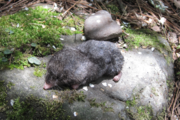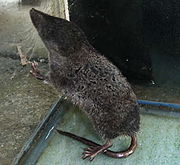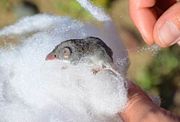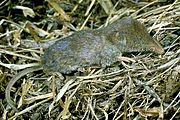
Soricinae is a subfamily of small mammals in the shrew family Soricidae, which in turn is part of the order Eulipotyphla. A member of this family is called a soricine or a red-toothed shrew. Soricinae is one of three subfamilies in Soricidae, along with the white-toothed shrews of Crocidurinae and the African shrews of Myosoricinae. They are found in Europe, Asia, North America, and northern South America, primarily in forests, shrublands, grasslands, and wetlands, and also in rocky areas and deserts. They range in size from the Eurasian pygmy shrew, at 3 cm (1 in) plus a 3 cm (1 in) tail, to various members of the Chimarrogale genus, at 14 cm (6 in) plus a 13 cm (5 in) tail. Soricines primarily eat insects and other invertebrates, as well as small vertebrates and plants. No soricines have population estimates, but 6 species are categorized as endangered species: the Bornean water shrew, Darién small-eared shrew, Enders's small-eared shrew, Guatemalan broad-clawed shrew, Sierra de Aroa shrew, and Pribilof Island shrew. Additionally, the Nelson's small-eared shrew, San Cristobal shrew, and Sclater's shrew are categorized as critically endangered.
The 158 extant species of Soricinae are divided into 13 genera; 76 of them are in Sorex and 41 in Cryptotis, with the remaining 41 species divided between the other 11 genera. A few extinct prehistoric soricines have been discovered, though due to ongoing research and discoveries the exact number and categorization is not fixed.
Conventions
| Conservation status | |
|---|---|
| EX | Extinct (0 species) |
| EW | Extinct in the wild (0 species) |
| CR | Critically Endangered (3 species) |
| EN | Endangered (6 species) |
| VU | Vulnerable (6 species) |
| NT | Near threatened (4 species) |
| LC | Least concern (103 species) |
| Other categories | |
| DD | Data deficient (34 species) |
| NE | Not evaluated (1 species) |
Conservation status codes listed follow the International Union for Conservation of Nature (IUCN) Red List of Threatened Species. Range maps are provided wherever possible; if a range map is not available, a description of the soricine's range is provided. Ranges are based on the IUCN Red List for that species unless otherwise noted.
Classification
The shrew subfamily Soricinae consists of thirteen genera. The majority of the species are contained within Cryptotis, with 41 species, and Sorex, with 76 species. The remaining shrews are split between Chodsigoa with eight species; Chimarrogale with six; Anourosorex, Episoriculus, Neomys, and Notiosorex with four species each; Blarina and Blarinella with three species each, and Megasorex, Nectogale, and Soriculus each with a single species.
Subfamily Soricinae
- Genus Anourosorex (Asian mole shrews): four species
- Genus Blarina (short-tailed shrews): three species
- Genus Blarinella (Asian short-tailed shrews): three species
- Genus Chimarrogale (Asiatic water shrews): six species
- Genus Chodsigoa (Asiatic shrews): eight species
- Genus Cryptotis (small-eared shrews): 41 species
- Genus Episoriculus (brown-toothed shrews): four species
- Genus Megasorex (Mexican shrew): one species
- Genus Nectogale (Elegant water shrew): one species
- Genus Neomys (water shrews): four species
- Genus Notiosorex (gray shrews): four species
- Genus Sorex (long-tailed shrews): 76 species
- Genus Soriculus (Himalayan shrew): one species
|
Soricines
The following classification is based on the taxonomy described by the reference work Mammal Species of the World (2005), with augmentation by generally accepted proposals made since using molecular phylogenetic analysis, as supported by both the IUCN and the American Society of Mammalogists.
| Common name | Scientific name and subspecies | Range | Size and ecology | IUCN status and estimated population |
|---|---|---|---|---|
| Assam mole shrew
|
A. assamensis Anderson, 1875 |
Northeastern India
|
Size: 8–12 cm (3–5 in) long, plus 0.5–2 cm (0.2–0.8 in) tail Habitat: Forest and rocky areas Diet: Insects and earthworms |
LC
|
| Chinese mole shrew
|
A. squamipes H. Milne-Edwards, 1872 |
Eastern Asia
|
Size: 8–11 cm (3–4 in), plus tail Habitat: Forest Diet: Insects and worms, as well as plants |
LC
|
| Giant mole shrew
|
A. schmidi Petter, 1963 |
Northeastern India and Bhutan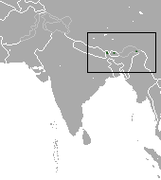
|
Size: 8–12 cm (3–5 in) long, plus 0.5–2 cm (0.2–0.8 in) tail Habitat: Forest Diet: Insects and earthworms |
DD
|
| Taiwanese mole shrew | A. yamashinai Kuroda, 1935 |
Taiwan
|
Size: 8–12 cm (3–5 in) long, plus 0.5–2 cm (0.2–0.8 in) tail Habitat: Forest and grassland Diet: Insects and earthworms |
LC
|
| Common name | Scientific name and subspecies | Range | Size and ecology | IUCN status and estimated population |
|---|---|---|---|---|
| Elliot's short-tailed shrew | B. hylophaga Elliot, 1899 |
Central United States
|
Size: 7–11 cm (3–4 in) long, plus 1–3 cm (0.4–1.2 in) tail Habitat: Grassland, shrubland, and forest Diet: Insects, arthropods, and earthworms, as well as small vertebrates and plants |
LC
|
| Everglades short-tailed shrew
|
B. peninsulae Merriam, 1895 |
Florida | Size: 7–11 cm (3–4 in) long, plus 1–3 cm (0.4–1.2 in) tail Habitat: Forest, shrubland, grassland, and inland wetlands Diet: Invertebrates, small vertebrates, and plants |
NE
|
| Northern short-tailed shrew | B. brevicauda (Say, 1823) |
Eastern North America
|
Size: 7–11 cm (3–4 in) long, plus 1–3 cm (0.4–1.2 in) tail Habitat: Inland wetlands, shrubland, and forest Diet: Invertebrates, small vertebrates, and plants |
LC
|
| Southern short-tailed shrew | B. carolinensis (Bachman, 1837) Two subspecies
|
Southeastern United States
|
Size: 7–11 cm (3–4 in) long, plus 1–3 cm (0.4–1.2 in) tail Habitat: Forest, shrubland, grassland, and inland wetlands Diet: Invertebrates, as well as plants |
LC
|
| Common name | Scientific name and subspecies | Range | Size and ecology | IUCN status and estimated population |
|---|---|---|---|---|
| Asiatic short-tailed shrew
|
B. quadraticauda H. Milne-Edwards, 1872 |
Central China
|
Size: 6–9 cm (2–4 in) long, plus 3–6 cm (1–2 in) tail Habitat: Forest and shrubland Diet: Invertebrates |
NT
|
| Burmese short-tailed shrew
|
B. wardi Thomas, 1915 |
Southern China and Myanmar
|
Size: 6–9 cm (2–4 in) long, plus 3–6 cm (1–2 in) tail Habitat: Forest Diet: Invertebrates |
LC
|
| Indochinese short-tailed shrew
|
B. griselda Thomas, 1912 |
Central and southern China and northern Vietnam
|
Size: 6–9 cm (2–4 in) long, plus 3–6 cm (1–2 in) tail Habitat: Forest Diet: Invertebrates |
LC
|
| Common name | Scientific name and subspecies | Range | Size and ecology | IUCN status and estimated population |
|---|---|---|---|---|
| Bornean water shrew
|
C. phaeura Thomas, 1898 |
Northern Borneo in Malaysia
|
Size: 8–14 cm (3–6 in) long, plus 6–13 cm (2–5 in) tail Habitat: Forest and inland wetlands Diet: Invertebrates |
EN
|
| Chinese water shrew
|
C. styani De Winton, 1899 |
Central China and Myanmar
|
Size: 8–14 cm (3–6 in) long, plus 6–13 cm (2–5 in) tail Habitat: Forest, shrubland, and inland wetlands Diet: Aquatic insects, crustaceans, and small fish |
LC
|
| Himalayan water shrew
|
C. himalayica (Gray, 1842) |
Eastern Asia
|
Size: 11–14 cm (4–6 in) long, plus 7–9 cm (3–4 in) tail Habitat: Forest and inland wetlands Diet: Insects and spiders |
LC
|
| Japanese water shrew | C. platycephalus Temminck, 1842 |
Japan
|
Size: 8–14 cm (3–6 in) long, plus 6–13 cm (2–5 in) tail Habitat: Inland wetlands Diet: Aquatic insects, crustaceans, and small fish |
LC
|
| Malayan water shrew
|
C. hantu Harrison, 1958 |
Malaysia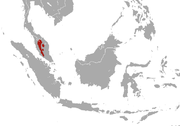
|
Size: 8–14 cm (3–6 in) long, plus 6–13 cm (2–5 in) tail Habitat: Forest and inland wetlands Diet: Aquatic insects, crustaceans, and small fish |
NT
|
| Sumatran water shrew
|
C. sumatrana (Thomas, 1921) |
Southern Sumatra in Indonesia
|
Size: 8–14 cm (3–6 in) long, plus 6–13 cm (2–5 in) tail Habitat: Forest and inland wetlands Diet: Aquatic insects, crustaceans, and small fish |
DD
|
| Common name | Scientific name and subspecies | Range | Size and ecology | IUCN status and estimated population |
|---|---|---|---|---|
| De Winton's shrew
|
C. hypsibia De Winton, 1899 |
Central China
|
Size: 4–10 cm (2–4 in) long, plus 3–12 cm (1–5 in) tail Habitat: Forest and shrubland Diet: Earthworms, insects, and other invertebrates, as well as small mammals |
LC
|
| Lamulate shrew
|
C. lamula (Thomas, 1912) |
Central China
|
Size: 4–10 cm (2–4 in) long, plus 3–12 cm (1–5 in) tail Habitat: Forest Diet: Earthworms, insects, and other invertebrates, as well as small mammals |
LC
|
| Lesser Taiwanese shrew
|
C. sodalis (Thomas, 1913) |
Taiwan
|
Size: 4–10 cm (2–4 in) long, plus 3–12 cm (1–5 in) tail Habitat: Forest Diet: Earthworms, insects, and other invertebrates, as well as small mammals |
DD
|
| Lowe's shrew
|
C. parca (Allen, 1923) Three subspecies
|
Southern Asia
|
Size: 4–10 cm (2–4 in) long, plus 3–12 cm (1–5 in) tail Habitat: Forest Diet: Earthworms, insects, and other invertebrates, as well as small mammals |
LC
|
| Pygmy brown-toothed shrew
|
C. parva Allen, 1923 |
Southern China
|
Size: 4–10 cm (2–4 in) long, plus 3–12 cm (1–5 in) tail Habitat: Unknown Diet: Earthworms, insects, and other invertebrates, as well as small mammals |
DD
|
| Salenski's shrew
|
C. salenskii (Kastchenko, 1907) |
Central China
|
Size: 4–10 cm (2–4 in) long, plus 3–12 cm (1–5 in) tail Habitat: Unknown Diet: Earthworms, insects, and other invertebrates, as well as small mammals |
DD
|
| Smith's shrew
|
C. smithii (Thomas, 1911) |
Central China
|
Size: 4–10 cm (2–4 in) long, plus 3–12 cm (1–5 in) tail Habitat: Forest Diet: Earthworms, insects, and other invertebrates, as well as small mammals |
NT
|
| Van Sung's shrew
|
C. caovansunga (Lunde, Musser, & Son, 2003) |
Northern Vietnam
|
Size: 4–10 cm (2–4 in) long, plus 3–12 cm (1–5 in) tail Habitat: Forest Diet: Earthworms, insects, and other invertebrates, as well as small mammals |
DD
|
| Common name | Scientific name and subspecies | Range | Size and ecology | IUCN status and estimated population |
|---|---|---|---|---|
| Big Mexican small-eared shrew
|
C. magna (Merriam, 1895) |
Southern Mexico
|
Size: 5–10 cm (2–4 in) long, plus 1–5 cm (0.4–2.0 in) tail Habitat: Forest Diet: Invertebrates, small lizards and frogs, and carrion |
VU
|
| Blackish small-eared shrew
|
C. nigrescens (J. A. Allen, 1895) |
Central America
|
Size: 5–10 cm (2–4 in) long, plus 1–5 cm (0.4–2.0 in) tail Habitat: Forest Diet: Invertebrates, small lizards and frogs, and carrion |
LC
|
| Blind small-eared shrew
|
C. niausa Moreno Cárdenas & Albuja, 2014 |
Northern Ecuador | Size: 5–10 cm (2–4 in) long, plus 1–5 cm (0.4–2.0 in) tail Habitat: Forest, grassland, and rocky areas Diet: Invertebrates, small lizards and frogs, and carrion |
DD
|
| Celaque broad-clawed shrew
|
C. celaque Woodman, 2015 |
Western Honduras | Size: 5–10 cm (2–4 in) long, plus 1–5 cm (0.4–2.0 in) tail Habitat: Forest Diet: Invertebrates, small lizards and frogs, and carrion |
DD
|
| Central American least shrew | C. orophila (Allen, 1895) |
Central America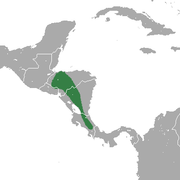
|
Size: 5–10 cm (2–4 in) long, plus 1–5 cm (0.4–2.0 in) tail Habitat: Forest, shrubland, and inland wetlands Diet: Invertebrates, small lizards and frogs, and carrion |
DD
|
| Central Mexican broad-clawed shrew
|
C. alticola (Merriam, 1895) |
Central Mexico
|
Size: 5–10 cm (2–4 in) long, plus 1–5 cm (0.4–2.0 in) tail Habitat: Forest and grassland Diet: Invertebrates, small lizards and frogs, and carrion |
DD
|
| Colombian small-eared shrew
|
C. colombiana Woodman & Timm, 1993 |
Central Colombia
|
Size: 5–10 cm (2–4 in) long, plus 1–5 cm (0.4–2.0 in) tail Habitat: Forest Diet: Invertebrates, small lizards and frogs, and carrion |
LC
|
| Darién small-eared shrew
|
C. merus Goldman, 1912 |
Border of Colombia and Panama
|
Size: 5–10 cm (2–4 in) long, plus 1–5 cm (0.4–2.0 in) tail Habitat: Forest Diet: Invertebrates, small lizards and frogs, and carrion |
EN
|
| Dinira small-eared shrew
|
C. dinirensis Quiroga-Carmona & DoNascimiento, 2016 |
Northern Venezuela | Size: 5–10 cm (2–4 in) long, plus 1–5 cm (0.4–2.0 in) tail Habitat: Forest Diet: Invertebrates, small lizards and frogs, and carrion |
DD
|
| Eastern Cordillera small-footed shrew
|
C. brachyonyx Woodman, 2003 |
Central Colombia
|
Size: 5–10 cm (2–4 in) long, plus 1–5 cm (0.4–2.0 in) tail Habitat: Unknown Diet: Invertebrates, small lizards and frogs, and carrion |
DD
|
| Ecuadorian small-eared shrew
|
C. equatoris Thomas, 1912 |
Ecuador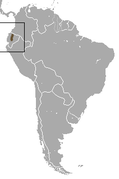
|
Size: 5–10 cm (2–4 in) long, plus 1–5 cm (0.4–2.0 in) tail Habitat: Forest and unknown Diet: Invertebrates, small lizards and frogs, and carrion |
LC
|
| Enders's small-eared shrew
|
C. endersi Setzer, 1950 |
Panama
|
Size: 5–10 cm (2–4 in) long, plus 1–5 cm (0.4–2.0 in) tail Habitat: Forest Diet: Invertebrates, small lizards and frogs, and carrion |
EN
|
| Goldman's broad-clawed shrew
|
C. goldmani (Merriam, 1895) |
Southern Mexico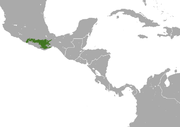
|
Size: 5–10 cm (2–4 in) long, plus 1–5 cm (0.4–2.0 in) tail Habitat: Forest Diet: Invertebrates, small lizards and frogs, and carrion |
LC
|
| Goodwin's broad-clawed shrew
|
C. goodwini Jackson, 1933 |
Southern Mexico and Central America
|
Size: 5–10 cm (2–4 in) long, plus 1–5 cm (0.4–2.0 in) tail Habitat: Forest Diet: Invertebrates, small lizards and frogs, and carrion |
LC
|
| Grizzled Mexican small-eared shrew
|
C. obscura (Merriam, 1895) |
Eastern Mexico | Size: 5–10 cm (2–4 in) long, plus 1–5 cm (0.4–2.0 in) tail Habitat: Forest Diet: Invertebrates, small lizards and frogs, and carrion |
LC
|
| Guatemalan broad-clawed shrew
|
C. griseoventris Jackson, 1933 |
Southern Mexico and Guatemala
|
Size: 5–10 cm (2–4 in) long, plus 1–5 cm (0.4–2.0 in) tail Habitat: Forest Diet: Invertebrates, small lizards and frogs, and carrion |
EN
|
| Honduran small-eared shrew
|
C. hondurensis Woodman & Timm, 1992 |
Honduras
|
Size: 5–10 cm (2–4 in) long, plus 1–5 cm (0.4–2.0 in) tail Habitat: Forest Diet: Invertebrates, small lizards and frogs, and carrion |
DD
|
| Mam broad-clawed shrew
|
C. mam Woodman, 2010 |
Guatemala | Size: 5–10 cm (2–4 in) long, plus 1–5 cm (0.4–2.0 in) tail Habitat: Forest Diet: Earthworms, insects, and plants |
DD
|
| Medellín small-eared shrew | C. medellinia Thomas, 1921 |
Colombia
|
Size: 5–10 cm (2–4 in) long, plus 1–5 cm (0.4–2.0 in) tail Habitat: Forest Diet: Invertebrates, small lizards and frogs, and carrion |
LC
|
| Merida small-eared shrew
|
C. meridensis Thomas, 1898 |
Venezuela
|
Size: 7–11 cm (3–4 in) long, plus 2–5 cm (1–2 in) tail Habitat: Forest and shrubland Diet: Insects and other invertebrates, as well as small vertebrates and eggs |
VU
|
| Merriam's small-eared shrew
|
C. merriami Choate, 1970 |
Southern Mexico and Central America
|
Size: 5–10 cm (2–4 in) long, plus 1–5 cm (0.4–2.0 in) tail Habitat: Forest Diet: Invertebrates, small lizards and frogs, and carrion |
LC
|
| Mexican small-eared shrew
|
C. mexicana (Coues, 1870) |
Southern Mexico
|
Size: 5–10 cm (2–4 in) long, plus 1–5 cm (0.4–2.0 in) tail Habitat: Forest Diet: Invertebrates, small lizards and frogs, and carrion |
LC
|
| Muscular broad-clawed shrew
|
C. lacertosus Woodman, 2010 |
Guatemala | Size: 5–10 cm (2–4 in) long, plus 1–5 cm (0.4–2.0 in) tail Habitat: Forest Diet: Invertebrates, small lizards and frogs, and carrion |
DD
|
| Nelson's small-eared shrew
|
C. nelsoni Merriam, 1895 |
Eastern Mexico
|
Size: 5–10 cm (2–4 in) long, plus 1–5 cm (0.4–2.0 in) tail Habitat: Forest and grassland Diet: Insects |
CR
|
| North American least shrew | C. parva (Say, 1823) |
Eastern North America
|
Size: 7–10 cm (3–4 in) long, plus 1–3 cm (0.4–1.2 in) tail Habitat: Forest, shrubland, grassland, inland wetlands, and rocky areas Diet: Insects, as well as other invertebrates |
LC
|
| Oaxacan broad-clawed shrew
|
C. peregrina (Merriam, 1895) |
Southern Mexico | Size: 5–10 cm (2–4 in) long, plus 1–5 cm (0.4–2.0 in) tail Habitat: Forest Diet: Invertebrates, small lizards and frogs, and carrion |
DD
|
| Omoa broad-clawed shrew
|
C. mccarthyi Woodman, 2015 |
Honduras | Size: 5–10 cm (2–4 in) long, plus 1–5 cm (0.4–2.0 in) tail Habitat: Forest Diet: Invertebrates, small lizards and frogs, and carrion |
DD
|
| Perija small-eared shrew
|
C. perijensis Quiroga-Carmona & Woodman, 2015 |
Border of Colombia and Venezuela | Size: 5–10 cm (2–4 in) long, plus 1–5 cm (0.4–2.0 in) tail Habitat: Forest and grassland Diet: Invertebrates, small lizards and frogs, and carrion |
DD
|
| Peruvian small-eared shrew
|
C. peruviensis Vivar, Pacheco, & Valqui, 1997 |
Northern Peru
|
Size: 5–10 cm (2–4 in) long, plus 1–5 cm (0.4–2.0 in) tail Habitat: Forest Diet: Invertebrates, small lizards and frogs, and carrion |
DD
|
| Phillips's small-eared shrew
|
C. phillipsii (Schaldach, 1966) |
Southern Mexico | Size: 5–10 cm (2–4 in) long, plus 1–5 cm (0.4–2.0 in) tail Habitat: Forest Diet: Invertebrates, small lizards and frogs, and carrion |
VU
|
| Santa Barbara broad-clawed shrew
|
C. cavatorculus Woodman, 2015 |
Honduras | Size: 5–10 cm (2–4 in) long, plus 1–5 cm (0.4–2.0 in) tail Habitat: Forest Diet: Invertebrates, small lizards and frogs, and carrion |
DD
|
| Scaly-footed small-eared shrew
|
C. squamipes (Allen, 1916) |
Colombia and Ecuador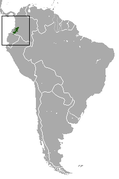
|
Size: 5–10 cm (2–4 in) long, plus 1–5 cm (0.4–2.0 in) tail Habitat: Forest Diet: Invertebrates, small lizards and frogs, and carrion |
LC
|
| Sierra de Aroa shrew
|
C. aroensis Quiroga-Carmona & Molinari, 2012 |
Venezuela | Size: 5–10 cm (2–4 in) long, plus 1–5 cm (0.4–2.0 in) tail Habitat: Forest Diet: Invertebrates, small lizards and frogs, and carrion |
EN
|
| Talamancan small-eared shrew
|
C. gracilis Miller, 1911 |
Costa Rica and Panama
|
Size: 5–10 cm (2–4 in) long, plus 1–5 cm (0.4–2.0 in) tail Habitat: Forest and grassland Diet: Invertebrates, small lizards and frogs, and carrion |
LC
|
| Tamá small-eared shrew
|
C. tamensis Woodman, 2002 |
Border of Colombia and Venezuela
|
Size: 5–10 cm (2–4 in) long, plus 1–5 cm (0.4–2.0 in) tail Habitat: Forest Diet: Invertebrates, small lizards and frogs, and carrion |
LC
|
| Thomas's small-eared shrew
|
C. thomasi (Merriam, 1897) |
Colombia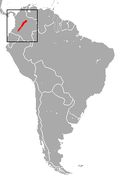
|
Size: 5–10 cm (2–4 in) long, plus 1–5 cm (0.4–2.0 in) tail Habitat: Forest and grassland Diet: Invertebrates, small lizards and frogs, and carrion |
LC
|
| Tropical small-eared shrew
|
C. tropicalis (Merriam, 1895) |
Southern Mexico and Central America
|
Size: 5–10 cm (2–4 in) long, plus 1–5 cm (0.4–2.0 in) tail Habitat: Forest, grassland, and inland wetlands Diet: Invertebrates, small lizards and frogs, and carrion |
DD
|
| Venezuelan small-eared shrew
|
C. venezuelensis Quiroga-Carmona, 2013 |
Northern Venezuela | Size: 5–10 cm (2–4 in) long, plus 1–5 cm (0.4–2.0 in) tail Habitat: Forest Diet: Invertebrates, small lizards and frogs, and carrion |
DD
|
| Wandering small-eared shrew
|
C. montivaga (Anthony, 1921) |
Ecuador
|
Size: 5–10 cm (2–4 in) long, plus 1–5 cm (0.4–2.0 in) tail Habitat: Forest Diet: Insects and other invertebrates |
LC
|
| Yalijux shrew
|
C. oreoryctes Woodman, 2011 |
Guatemala | Size: 5–10 cm (2–4 in) long, plus 1–5 cm (0.4–2.0 in) tail Habitat: Forest Diet: Invertebrates, small lizards and frogs, and carrion |
DD
|
| Yucatan small-eared shrew
|
C. mayensis (Merriam, 1901) |
Southern Mexico and Central America
|
Size: 5–10 cm (2–4 in) long, plus 1–5 cm (0.4–2.0 in) tail Habitat: Forest Diet: Invertebrates, small lizards and frogs, and carrion |
LC
|
| Common name | Scientific name and subspecies | Range | Size and ecology | IUCN status and estimated population |
|---|---|---|---|---|
| Hodgson's brown-toothed shrew
|
E. caudatus (Horsfield, 1851) |
Southern Asia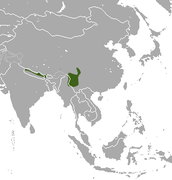
|
Size: 4–7 cm (2–3 in) long, plus 3–7 cm (1–3 in) tail Habitat: Forest, shrubland, and grassland Diet: Earthworms, insects, and other invertebrates, as well as small mammals |
LC
|
| Long-tailed brown-toothed shrew
|
E. leucops (Horsfield, 1855) |
Southern Asia
|
Size: 4–7 cm (2–3 in) long, plus 3–7 cm (1–3 in) tail Habitat: Forest Diet: Earthworms, insects, and other invertebrates, as well as small mammals |
LC
|
| Long-tailed mountain shrew
|
E. macrurus Blanford, 1888 |
Southern Asia
|
Size: 4–7 cm (2–3 in) long, plus 3–7 cm (1–3 in) tail Habitat: Forest Diet: Earthworms, insects, and other invertebrates, as well as small mammals |
LC
|
| Taiwanese brown-toothed shrew
|
E. fumidus (Thomas, 1913) |
Taiwan
|
Size: 4–7 cm (2–3 in) long, plus 3–7 cm (1–3 in) tail Habitat: Forest and shrubland Diet: Earthworms, insects, and other invertebrates, as well as small mammals |
LC
|
| Common name | Scientific name and subspecies | Range | Size and ecology | IUCN status and estimated population |
|---|---|---|---|---|
| Mexican shrew
|
M. gigas (Merriam, 1897) |
Southern Mexico
|
Size: 8–9 cm (3–4 in) long, plus 3–5 cm (1–2 in) tail Habitat: Forest and shrubland Diet: Invertebrates |
LC
|
| Common name | Scientific name and subspecies | Range | Size and ecology | IUCN status and estimated population |
|---|---|---|---|---|
| Elegant water shrew
|
N. elegans H. Milne-Edwards, 1870 |
Central China and southern Asia
|
Size: 9–13 cm (4–5 in) long, plus 8–11 cm (3–4 in) tail Habitat: Forest and inland wetlands Diet: Insects, crustaceans, and small fish |
LC
|
| Common name | Scientific name and subspecies | Range | Size and ecology | IUCN status and estimated population |
|---|---|---|---|---|
| Eurasian water shrew | N. fodiens (Pennant, 1771) |
Europe and Asia
|
Size: 6–10 cm (2–4 in) long, plus 4–8 cm (2–3 in) tail Habitat: Forest, grassland, inland wetlands, intertidal marine, and coastal marine Diet: Aquatic invertebrates, fish, amphibians, and frogs |
LC
|
| Iberian water shrew
|
N. anomalus A. Cabrera, 1907 |
Western Europe | Size: 6–10 cm (2–4 in) long, plus 4–8 cm (2–3 in) tail Habitat: Inland wetlands Diet: Invertebrates and small vertebrates such as fish and frogs |
LC
|
| Mediterranean water shrew | N. milleri Mottaz, 1907 |
Europe and western Asia
|
Size: 6–10 cm (2–4 in) long, plus 4–8 cm (2–3 in) tail Habitat: Inland wetlands Diet: Invertebrates and small vertebrates such as fish and frogs |
LC
|
| Transcaucasian water shrew
|
N. teres Miller, 1908 |
Western Asia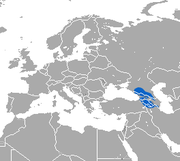
|
Size: 6–10 cm (2–4 in) long, plus 4–8 cm (2–3 in) tail Habitat: Forest and inland wetlands Diet: Invertebrates, molluscs, fish, frogs, and small rodents |
LC
|
| Common name | Scientific name and subspecies | Range | Size and ecology | IUCN status and estimated population |
|---|---|---|---|---|
| Cockrum's gray shrew | N. cockrumi Baker, O'Neill, & McAliley, 2003 |
Northern Mexico and southern United States
|
Size: 4–7 cm (2–3 in) long, plus 2–4 cm (1–2 in) tail Habitat: Shrubland and desert Diet: Insects and other invertebrates, as well as carrion |
LC
|
| Crawford's gray shrew | N. crawfordi (Coues, 1877) |
Southern North America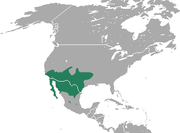
|
Size: 4–7 cm (2–3 in) long, plus 2–4 cm (1–2 in) tail Habitat: Forest, shrubland, grassland, and desert Diet: Worms, spiders, and insects, as well as small mammals, lizards, and birds |
LC
|
| Large-eared gray shrew
|
N. evotis (Coues, 1877) |
Western Mexico
|
Size: 4–7 cm (2–3 in) long, plus 2–4 cm (1–2 in) tail Habitat: Shrubland and grassland Diet: Insects and other invertebrates, as well as carrion |
LC
|
| Villa's gray shrew
|
N. villai Carraway & Timm, 2000 |
Eastern Mexico
|
Size: 4–7 cm (2–3 in) long, plus 2–4 cm (1–2 in) tail Habitat: Forest Diet: Insects and other invertebrates, as well as carrion |
VU
|
| Common name | Scientific name and subspecies | Range | Size and ecology | IUCN status and estimated population |
|---|---|---|---|---|
| Alaska tiny shrew
|
S. yukonicus Dokuchaev, 1997 |
Alaska
|
Size: 4–10 cm (2–4 in) long, plus 2–9 cm (1–4 in) tail Habitat: Inland wetlands Diet: Insects, worms, and other invertebrates, as well as small vertebrates, carrion, and plants |
LC
|
| Alpine shrew
|
S. alpinus Schinz, 1837 |
Europe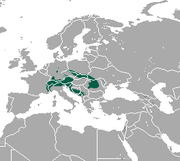
|
Size: 6–8 cm (2–3 in) long, plus 5–8 cm (2–3 in) tail Habitat: Forest, grassland, and rocky areas Diet: Insects, arachnids, snails, and earthworms |
NT
|
| American pygmy shrew
|
S. hoyi Baird, 1857 |
Northern North America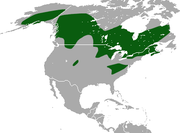
|
Size: 5–6 cm (2 in) long, plus 2–4 cm (1–2 in) tail Habitat: Forest, shrubland, grassland, and inland wetlands Diet: Insects and other invertebrates |
LC
|
| American water shrew | S. palustris Richardson, 1828 |
North America
|
Size: 7–9 cm (3–4 in) long, plus 5–9 cm (2–4 in) tail Habitat: Forest and inland wetlands Diet: Aquatic insects and fish, as well as other invertebrates and plants |
LC
|
| Apennine shrew
|
S. samniticus Altobello, 1926 |
Italy
|
Size: 4–10 cm (2–4 in) long, plus 2–9 cm (1–4 in) tail Habitat: Shrubland and forest Diet: Insects, worms, and other invertebrates, as well as small vertebrates, carrion, and plants |
LC
|
| Arctic shrew
|
S. arcticus Kerr, 1792 |
Northern North America
|
Size: 6–8 cm (2–3 in) long, plus 3–5 cm (1–2 in) tail Habitat: Forest and inland wetlands Diet: Insects and other invertebrates |
LC
|
| Arizona shrew
|
S. arizonae Diersing & Hoffmeister, 1977 |
Northern Mexico and southern United States
|
Size: 4–10 cm (2–4 in) long, plus 2–9 cm (1–4 in) tail Habitat: Forest and inland wetlands Diet: Insects, worms, and other invertebrates, as well as small vertebrates, carrion, and plants |
LC
|
| Azumi shrew
|
S. hosonoi Imaizumi, 1954 |
Japan
|
Size: 4–10 cm (2–4 in) long, plus 2–9 cm (1–4 in) tail Habitat: Forest, shrubland, and grassland Diet: Insects, worms, and other invertebrates, as well as small vertebrates, carrion, and plants |
LC
|
| Baird's shrew | S. bairdi Merriam, 1895 |
Northwestern United States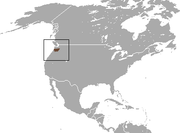
|
Size: 4–10 cm (2–4 in) long, plus 2–9 cm (1–4 in) tail Habitat: Forest Diet: Invertebrates |
LC
|
| Barren ground shrew
|
S. ugyunak Anderson & Rand, 1945 |
Northern North America
|
Size: 4–10 cm (2–4 in) long, plus 2–9 cm (1–4 in) tail Habitat: Grassland Diet: Insects, worms, and other invertebrates, as well as small vertebrates, carrion, and plants |
LC
|
| Buchara shrew | S. buchariensis Ognew, 1921 |
Central Asia
|
Size: 4–10 cm (2–4 in) long, plus 2–9 cm (1–4 in) tail Habitat: Forest Diet: Insects |
DD
|
| Carmen Mountain shrew
|
S. milleri Jackson, 1947 |
Northeastern Mexico
|
Size: 4–10 cm (2–4 in) long, plus 2–9 cm (1–4 in) tail Habitat: Forest Diet: Insects |
VU
|
| Caucasian pygmy shrew | S. volnuchini Ognew, 1922 |
Western Asia
|
Size: 4–10 cm (2–4 in) long, plus 2–9 cm (1–4 in) tail Habitat: Forest and grassland Diet: Insects, worms, and other invertebrates, as well as small vertebrates, carrion, and plants |
LC
|
| Caucasian shrew
|
S. satunini Ognew, 1922 |
Western Asia
|
Size: 4–10 cm (2–4 in) long, plus 2–9 cm (1–4 in) tail Habitat: Forest and rocky areas Diet: Insects |
LC
|
| Chestnut-bellied shrew
|
S. ventralis Merriam, 1895 |
Southern Mexico
|
Size: 4–10 cm (2–4 in) long, plus 2–9 cm (1–4 in) tail Habitat: Forest and grassland Diet: Insects, worms, and other invertebrates, as well as small vertebrates, carrion, and plants |
LC
|
| Chinese highland shrew
|
S. excelsus Allen, 1923 |
Southern China
|
Size: 4–10 cm (2–4 in) long, plus 2–9 cm (1–4 in) tail Habitat: Forest, shrubland, and grassland Diet: Insects, worms, and other invertebrates, as well as small vertebrates, carrion, and plants |
LC
|
| Chinese shrew
|
S. sinalis Thomas, 1912 |
Central China
|
Size: 4–10 cm (2–4 in) long, plus 2–9 cm (1–4 in) tail Habitat: Rocky areas Diet: Insects, worms, and other invertebrates, as well as small vertebrates, carrion, and plants |
DD
|
| Cinereus shrew | S. cinereus Kerr, 1792 |
Northern North America
|
Size: 4–10 cm (2–4 in) long, plus 2–9 cm (1–4 in) tail Habitat: Forest, shrubland, grassland, and inland wetlands Diet: A variety of invertebrates, as well as seeds and fungi |
LC
|
| Common shrew | S. araneus Linnaeus, 1758 |
Europe and Asia
|
Size: 4–10 cm (2–4 in) long, plus 2–9 cm (1–4 in) tail Habitat: Forest, shrubland, inland wetlands, and coastal marine Diet: Insects and other invertebrates |
LC
|
| Crowned shrew | S. coronatus Millet, 1828 |
Western Europe
|
Size: 4–10 cm (2–4 in) long, plus 2–9 cm (1–4 in) tail Habitat: Forest, shrubland, and inland wetlands Diet: Insects, worms, and other invertebrates, as well as small vertebrates, carrion, and plants |
LC
|
| Dwarf shrew
|
S. nanus Merriam, 1895 |
Central United States
|
Size: 4–10 cm (2–4 in) long, plus 2–9 cm (1–4 in) tail Habitat: Rocky areas, inland wetlands, grassland, and forest Diet: Insects and other invertebrates, as well as plants and small vertebrates |
LC
|
| Eurasian least shrew | S. minutissimus Zimmermann, 1780 |
Norther Europe and northern Asia
|
Size: 4–10 cm (2–4 in) long, plus 2–9 cm (1–4 in) tail Habitat: Forest and grassland Diet: Insects and other invertebrates |
LC
|
| Eurasian pygmy shrew | S. minutus Linnaeus, 1766 |
Europe and Asia
|
Size: 3–6 cm (1–2 in) long, plus 3–5 cm (1–2 in) tail Habitat: Forest, shrubland, grassland, inland wetlands, and coastal marine Diet: Insects and other invertebrates |
LC
|
| Flat-skulled shrew
|
S. roboratus Hollister, 1913 |
Northern Asia
|
Size: 4–10 cm (2–4 in) long, plus 2–9 cm (1–4 in) tail Habitat: Forest Diet: Insects |
LC
|
| Fog shrew
|
S. sonomae Jackson, 1921 Two subspecies
|
Western North America
|
Size: 4–10 cm (2–4 in) long, plus 2–9 cm (1–4 in) tail Habitat: Forest and inland wetlands Diet: Insects and other invertebrates |
LC
|
| Gansu shrew
|
S. cansulus Thomas, 1912 |
Central China
|
Size: 4–10 cm (2–4 in) long, plus 2–9 cm (1–4 in) tail Habitat: Unknown Diet: Insects, worms, and other invertebrates, as well as small vertebrates, carrion, and plants |
DD
|
| Glacier Bay water shrew
|
S. alaskanus Merriam, 1900 |
Western Canada
|
Size: 4–10 cm (2–4 in) long, plus 2–9 cm (1–4 in) tail Habitat: Inland wetlands Diet: Insects, worms, and other invertebrates, as well as small vertebrates, carrion, and plants |
DD
|
| Greater stripe-backed shrew
|
S. cylindricauda H. Milne-Edwards, 1872 |
Central China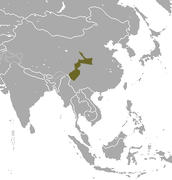
|
Size: 4–10 cm (2–4 in) long, plus 2–9 cm (1–4 in) tail Habitat: Forest Diet: Insects, worms, and other invertebrates, as well as small vertebrates, carrion, and plants |
LC
|
| Iberian shrew | S. granarius Miller, 1910 |
Portugal and Spain
|
Size: 4–10 cm (2–4 in) long, plus 2–9 cm (1–4 in) tail Habitat: Forest, shrubland, and rocky areas Diet: Insects, worms, and other invertebrates, as well as small vertebrates, carrion, and plants |
LC
|
| Inyo shrew | S. tenellus Merriam, 1895 |
Western United States
|
Size: 4–10 cm (2–4 in) long, plus 2–9 cm (1–4 in) tail Habitat: Forest, shrubland, inland wetlands, and rocky areas Diet: Insects and other invertebrates |
LC
|
| Ixtlan shrew
|
S. ixtlanensis Carraway, 2007 |
Southern Mexico | Size: 4–10 cm (2–4 in) long, plus 2–9 cm (1–4 in) tail Habitat: Forest Diet: Insects, worms, and other invertebrates, as well as small vertebrates, carrion, and plants |
DD
|
| Jalisco shrew
|
S. mediopua Carraway, 2007 |
Southern Mexico | Size: 4–10 cm (2–4 in) long, plus 2–9 cm (1–4 in) tail Habitat: Forest Diet: Insects, worms, and other invertebrates, as well as small vertebrates, carrion, and plants |
LC
|
| Kamchatka shrew
|
S. camtschatica Yudin, 1972 |
Eastern Russia
|
Size: 4–10 cm (2–4 in) long, plus 2–9 cm (1–4 in) tail Habitat: Shrubland Diet: Insects, worms, and other invertebrates, as well as small vertebrates, carrion, and plants |
LC
|
| Kashmir pygmy shrew
|
S. planiceps Miller, 1911 |
Northern India and Pakistan
|
Size: 4–10 cm (2–4 in) long, plus 2–9 cm (1–4 in) tail Habitat: Forest and rocky areas Diet: Insects, worms, and other invertebrates, as well as small vertebrates, carrion, and plants |
LC
|
| Kozlov's shrew
|
S. kozlovi Stroganov, 1952 |
South-central China
|
Size: 4–10 cm (2–4 in) long, plus 2–9 cm (1–4 in) tail Habitat: Unknown Diet: Insects, worms, and other invertebrates, as well as small vertebrates, carrion, and plants |
DD
|
| Large-toothed shrew
|
S. macrodon Merriam, 1895 |
Southern Mexico
|
Size: 4–10 cm (2–4 in) long, plus 2–9 cm (1–4 in) tail Habitat: Forest Diet: Insects, worms, and other invertebrates, as well as small vertebrates, carrion, and plants |
VU
|
| Laxmann's shrew | S. caecutiens Laxmann, 1788 |
Northern Europe and northern Asia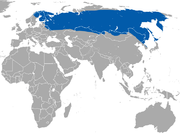
|
Size: 4–10 cm (2–4 in) long, plus 2–9 cm (1–4 in) tail Habitat: Forest, shrubland, and inland wetlands Diet: Insects and other invertebrates |
LC
|
| Lesser striped shrew
|
S. bedfordiae Thomas, 1911 |
Central China and southern Asia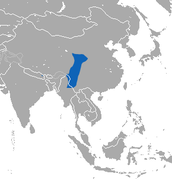
|
Size: 4–10 cm (2–4 in) long, plus 2–9 cm (1–4 in) tail Habitat: Forest and grassland Diet: Insects |
LC
|
| Long-clawed shrew | S. unguiculatus Dobson, 1890 |
Eastern Asia
|
Size: 4–10 cm (2–4 in) long, plus 2–9 cm (1–4 in) tail Habitat: Forest and grassland Diet: Insects and other invertebrates |
LC
|
| Long-tailed shrew | S. dispar Batchelder, 1911 |
Eastern North America
|
Size: 4–10 cm (2–4 in) long, plus 2–9 cm (1–4 in) tail Habitat: Forest, inland wetlands, and rocky areas Diet: Small invertebrates and plants |
LC
|
| Maritime shrew
|
S. maritimensis Smith, 1939 |
Eastern Canada
|
Size: 4–10 cm (2–4 in) long, plus 2–9 cm (1–4 in) tail Habitat: Forest, inland wetlands, and unknown Diet: Insects, worms, and other invertebrates, as well as small vertebrates, carrion, and plants |
LC
|
| Marsh shrew | S. bendirii Merriam, 1884 |
Western North America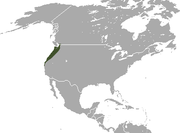
|
Size: 4–10 cm (2–4 in) long, plus 2–9 cm (1–4 in) tail Habitat: Forest and inland wetlands Diet: Insects |
LC
|
| Merriam's shrew | S. merriami Dobson, 1890 |
Western United States
|
Size: 5–7 cm (2–3 in) long, plus 3–5 cm (1–2 in) tail Habitat: Forest, shrubland, and grassland Diet: Insects and other invertebrates, as well as small vertebrates |
LC
|
| Mexican long-tailed shrew
|
S. oreopolus Merriam, 1892 |
Southern Mexico
|
Size: 4–10 cm (2–4 in) long, plus 2–9 cm (1–4 in) tail Habitat: Forest and grassland Diet: Insects, worms, and other invertebrates, as well as small vertebrates, carrion, and plants |
LC
|
| Montane shrew | S. monticolus Merriam, 1890 |
Western North America
|
Size: 6–8 cm (2–3 in) long, plus 4–7 cm (2–3 in) tail Habitat: Forest, grassland, and inland wetlands Diet: Insects and other invertebrates, as well as salamanders, seeds, lichen, and fungi |
LC
|
| Mount Lyell shrew
|
S. lyelli Merriam, 1902 |
Western United States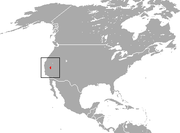
|
Size: 4–10 cm (2–4 in) long, plus 2–9 cm (1–4 in) tail Habitat: Shrubland, grassland, and inland wetlands Diet: Insects |
LC
|
| New Mexico shrew
|
S. neomexicanus Bailey, 1913 |
Southern United States
|
Size: 4–10 cm (2–4 in) long, plus 2–9 cm (1–4 in) tail Habitat: Forest and grassland Diet: Insects, worms, and other invertebrates, as well as small vertebrates, carrion, and plants |
DD
|
| Orizaba long-tailed shrew
|
S. orizabae Merriam, 1895 |
Central Mexico
|
Size: 4–10 cm (2–4 in) long, plus 2–9 cm (1–4 in) tail Habitat: Forest and grassland Diet: Insects, worms, and other invertebrates, as well as small vertebrates, carrion, and plants |
LC
|
| Ornate shrew | S. ornatus Merriam, 1895 Eight subspecies
|
Western North America
|
Size: 4–10 cm (2–4 in) long, plus 2–9 cm (1–4 in) tail Habitat: Forest, shrubland, grassland, and inland wetlands Diet: Insects, worms, and other invertebrates, as well as small vertebrates, carrion, and plants |
LC
|
| Pacific shrew
|
S. pacificus Coues, 1877 Two subspecies
|
Western United States
|
Size: 8–9 cm (3–4 in) long, plus 5–8 cm (2–3 in) tail Habitat: Forest Diet: Insects, other invertebrates, and amphibians, as well as plants and fungi |
LC
|
| Paramushir shrew
|
S. leucogaster Kuroda, 1933 |
Eastern Russia
|
Size: 4–10 cm (2–4 in) long, plus 2–9 cm (1–4 in) tail Habitat: Shrubland Diet: Insects, worms, and other invertebrates, as well as small vertebrates, carrion, and plants |
DD
|
| Portenko's shrew
|
S. portenkoi Stroganov, 1956 |
Eastern Russia
|
Size: 4–10 cm (2–4 in) long, plus 2–9 cm (1–4 in) tail Habitat: Grassland Diet: Insects, worms, and other invertebrates, as well as small vertebrates, carrion, and plants |
DD
|
| Prairie shrew
|
S. haydeni Baird, 1857 |
Central North America
|
Size: 4–10 cm (2–4 in) long, plus 2–9 cm (1–4 in) tail Habitat: Forest, shrubland, grassland, and inland wetlands Diet: Insects and other invertebrates, as well as small vertebrates and plants |
LC
|
| Preble's shrew
|
S. preblei Jackson, 1922 |
Northwestern United States
|
Size: 4–10 cm (2–4 in) long, plus 2–9 cm (1–4 in) tail Habitat: Forest, shrubland, grassland, inland wetlands, and desert Diet: Insects |
LC
|
| Pribilof Island shrew
|
S. pribilofensis Merriam, 1895 |
Pribilof Islands in Alaska
|
Size: 4–10 cm (2–4 in) long, plus 2–9 cm (1–4 in) tail Habitat: Grassland and coastal marine Diet: Insects, worms, and other invertebrates, as well as small vertebrates, carrion, and plants |
EN
|
| Radde's shrew
|
S. raddei Satunin, 1895 |
Western Asia
|
Size: 4–10 cm (2–4 in) long, plus 2–9 cm (1–4 in) tail Habitat: Forest and rocky areas Diet: Insects |
LC
|
| Saint Lawrence Island shrew
|
S. jacksoni Hall & Gilmore, 1932 |
St. Lawrence Island in Alaska
|
Size: 4–10 cm (2–4 in) long, plus 2–9 cm (1–4 in) tail Habitat: Grassland, inland wetlands, and rocky areas Diet: Insects |
LC
|
| San Cristobal shrew
|
S. stizodon Merriam, 1895 |
Southeastern Mexico
|
Size: 4–10 cm (2–4 in) long, plus 2–9 cm (1–4 in) tail Habitat: Forest Diet: Insects, worms, and other invertebrates, as well as small vertebrates, carrion, and plants |
CR
|
| Saussure's shrew
|
S. saussurei Merriam, 1892 |
Southern Mexico and Guatemala
|
Size: 4–10 cm (2–4 in) long, plus 2–9 cm (1–4 in) tail Habitat: Forest Diet: Insects, worms, and other invertebrates, as well as small vertebrates, carrion, and plants |
LC
|
| Sclater's shrew
|
S. sclateri Merriam, 1897 |
Southern Mexico and Guatemala
|
Size: 4–10 cm (2–4 in) long, plus 2–9 cm (1–4 in) tail Habitat: Forest Diet: Insects, worms, and other invertebrates, as well as small vertebrates, carrion, and plants |
CR
|
| Shinto shrew
|
S. shinto Thomas, 1905 Three subspecies
|
Japan
|
Size: 4–10 cm (2–4 in) long, plus 2–9 cm (1–4 in) tail Habitat: Forest and shrubland Diet: Insects, worms, and other invertebrates, as well as small vertebrates, carrion, and plants |
LC
|
| Siberian large-toothed shrew
|
S. daphaenodon Thomas, 1907 |
Northern Asia
|
Size: 4–10 cm (2–4 in) long, plus 2–9 cm (1–4 in) tail Habitat: Inland wetlands and forest Diet: Insects and other invertebrates |
LC
|
| Slender shrew
|
S. gracillimus Thomas, 1907 Four subspecies
|
Eastern Asia
|
Size: 4–10 cm (2–4 in) long, plus 2–9 cm (1–4 in) tail Habitat: Forest and grassland Diet: Invertebrates |
LC
|
| Smoky shrew | S. fumeus Miller, 1895 |
Eastern North America
|
Size: 4–10 cm (2–4 in) long, plus 2–9 cm (1–4 in) tail Habitat: Forest and shrubland Diet: Invertebrates, as well as salamanders and fungi |
LC
|
| Southeastern shrew | S. longirostris Bachman, 1837 Three subspecies
|
Eastern United States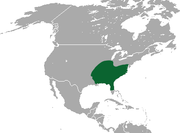
|
Size: 4–6 cm (2–2 in) long, plus 2–4 cm (1–2 in) tail Habitat: Inland wetlands, grassland, shrubland, and forest Diet: Insects and other invertebrates as well as seeds |
LC
|
| Taiga shrew
|
S. isodon Turov, 1924 |
Northern Europe and northern Asia
|
Size: 4–10 cm (2–4 in) long, plus 2–9 cm (1–4 in) tail Habitat: Forest and shrubland Diet: Insects, worms, and other invertebrates, as well as small vertebrates, carrion, and plants |
LC
|
| Tibetan shrew
|
S. thibetanus Kaschtschenko, 1905 |
Central China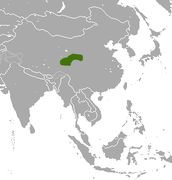
|
Size: 4–10 cm (2–4 in) long, plus 2–9 cm (1–4 in) tail Habitat: Forest, shrubland, and grassland Diet: Insects, worms, and other invertebrates, as well as small vertebrates, carrion, and plants |
DD
|
| Tien Shan shrew
|
S. asper Thomas, 1914 |
Central Asia
|
Size: 4–10 cm (2–4 in) long, plus 2–9 cm (1–4 in) tail Habitat: Forest and shrubland Diet: Insects and other invertebrates |
LC
|
| Trowbridge's shrew | S. trowbridgii Baird, 1857 |
Western North America
|
Size: 4–10 cm (2–4 in) long, plus 2–9 cm (1–4 in) tail Habitat: Forest, shrubland, and inland wetlands Diet: Insects and other invertebrates |
LC
|
| Tundra shrew | S. tundrensis Merriam, 1900 |
Asia and western North America
|
Size: 8–12 cm (3–5 in) long, plus 2–4 cm (1–2 in) tail Habitat: Forest, grassland, and inland wetlands Diet: Insects, other invertebrates, and flowers |
LC
|
| Ussuri shrew
|
S. mirabilis Ognew, 1937 |
Eastern Asia
|
Size: 4–10 cm (2–4 in) long, plus 2–9 cm (1–4 in) tail Habitat: Forest Diet: Insects, worms, and other invertebrates, as well as small vertebrates, carrion, and plants |
DD
|
| Vagrant shrew | S. vagrans Baird, 1857 |
Western North America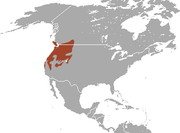
|
Size: 4–10 cm (2–4 in) long, plus 2–9 cm (1–4 in) tail Habitat: Forest and inland wetlands Diet: Insects and other invertebrates |
LC
|
| Valais shrew | S. antinorii Bonaparte, 1840 |
Southern Europe
|
Size: 4–10 cm (2–4 in) long, plus 2–9 cm (1–4 in) tail Habitat: Inland wetlands Diet: Insects, worms, and other invertebrates, as well as small vertebrates, carrion, and plants |
LC
|
| Veracruz shrew
|
S. veraecrucis Jackson, 1925 |
Mexico
|
Size: 4–10 cm (2–4 in) long, plus 2–9 cm (1–4 in) tail Habitat: Forest Diet: Insects, worms, and other invertebrates, as well as small vertebrates, carrion, and plants |
LC
|
| Verapaz shrew
|
S. veraepacis Alston, 1877 Three subspecies
|
Southern Mexico and Guatemala
|
Size: 4–10 cm (2–4 in) long, plus 2–9 cm (1–4 in) tail Habitat: Forest Diet: Insects, worms, and other invertebrates, as well as small vertebrates, carrion, and plants |
LC
|
| Zacatecas shrew
|
S. emarginatus Jackson, 1925 |
Central Mexico
|
Size: 4–10 cm (2–4 in) long, plus 2–9 cm (1–4 in) tail Habitat: Forest Diet: Insects, worms, and other invertebrates, as well as small vertebrates, carrion, and plants |
LC
|
| Common name | Scientific name and subspecies | Range | Size and ecology | IUCN status and estimated population |
|---|---|---|---|---|
| Himalayan shrew | S. nigrescens (Gray, 1842) |
Himalayas in Asia
|
Size: 8–10 cm (3–4 in) long, plus 3–7 cm (1–3 in) tail Habitat: Forest, shrubland, and rocky areas Diet: Earthworms, insects, and other invertebrates, as well as small mammals |
LC
|
References
- "Fossilworks: Soricidae". Paleobiology Database. University of Wisconsin–Madison. Archived from the original on May 31, 2023. Retrieved April 22, 2024.
- Dubey, S.; Salamin, N.; Ohdachi, S. D.; Barrière, P.; Vogel, P. (2007). "Molecular phylogenetics of shrews (Mammalia: Soricidae) reveal timing of transcontinental colonizations". Molecular Phylogenetics and Evolution. 44 (1): 126–137. Bibcode:2007MolPE..44..126D. doi:10.1016/j.ympev.2006.12.002. PMID 17267241.
- Bover, P.; Mitchell, K. J.; Llamas, B.; Rofes, J.; Thomson, V. A.; Cuenca-Bescós, G.; Alcover, J. A.; Cooper, A.; Pons, J. (2018). "Molecular phylogenetics supports the origin of an endemic Balearic shrew lineage (Nesiotites) coincident with the Messinian Salinity Crisis". Molecular Phylogenetics and Evolution. 125: 188–195. Bibcode:2018MolPE.125..188B. doi:10.1016/j.ympev.2018.03.028. PMID 29608962. S2CID 5010906. Archived from the original on May 23, 2024.
- Carraway, L. N. (2010). "Fossil history of Notiosorex (Soricomorpha: Soricidae) shrews with descriptions of new species". Western North American Naturalist. 70 (2): 144–163. doi:10.3398/064.070.0202. S2CID 86042657. Archived from the original on November 28, 2020.
- Wilson, Reeder, pp. 267–299
- ^ Nowak, p. 216
- ^ Molur, S. (2016). "Anourosorex assamensis". IUCN Red List of Threatened Species. 2016: e.T136802A22311877. doi:10.2305/IUCN.UK.2016-2.RLTS.T136802A22311877.en.
- ^ Friesen, Jarrett (2017). "Anourosorex squamipes". Animal Diversity Web. University of Michigan. Archived from the original on March 17, 2024. Retrieved March 30, 2024.
- ^ Molur, S. (2017) . "Anourosorex squamipes". IUCN Red List of Threatened Species. 2016: e.T41450A115186957. doi:10.2305/IUCN.UK.2016-3.RLTS.T41450A22311769.en.
- ^ Molur, S. (2017) . "Anourosorex schmidi". IUCN Red List of Threatened Species. 2016: e.T136589A115210155. doi:10.2305/IUCN.UK.2016-3.RLTS.T136589A22312034.en.
- ^ Smith, A. T. (2016). "Anourosorex yamashinai". IUCN Red List of Threatened Species. 2016: e.T136257A22311945. doi:10.2305/IUCN.UK.2016-1.RLTS.T136257A22311945.en.
- ^ Begnoche, Dana (2011). "Blarina hylophaga". Animal Diversity Web. University of Michigan. Archived from the original on March 31, 2024. Retrieved March 30, 2024.
- ^ Cassola, F. (2017) . "Blarina hylophaga". IUCN Red List of Threatened Species. 2016: e.T41453A115187348. doi:10.2305/IUCN.UK.2016-3.RLTS.T41453A22292879.en.
- ^ Nowak, p. 210
- ^ Ballenger, Liz (2011). "Blarina brevicauda". Animal Diversity Web. University of Michigan. Archived from the original on March 15, 2024. Retrieved March 30, 2024.
- ^ Cassola, F. (2017) . "Blarina brevicauda". IUCN Red List of Threatened Species. 2016: e.T41451A115187102. doi:10.2305/IUCN.UK.2016-3.RLTS.T41451A22292945.en.
- ^ Foust, Desirae (2011). "Blarina carolinensis". Animal Diversity Web. University of Michigan. Archived from the original on March 31, 2024. Retrieved March 30, 2024.
- ^ Cassola, F. (2017) . "Blarina carolinensis". IUCN Red List of Threatened Species. 2016: e.T41452A115187223. doi:10.2305/IUCN.UK.2016-3.RLTS.T41452A22293016.en.
- ^ Nowak, p. 208
- ^ Johnston, C.; Smith, A. T. (2016). "Blarinella quadraticauda". IUCN Red List of Threatened Species. 2016: e.T40613A22283477. doi:10.2305/IUCN.UK.2016-1.RLTS.T40613A22283477.en.
- ^ Cassola, F. (2016). "Blarinella wardi". IUCN Red List of Threatened Species. 2016: e.T2825A22283369. doi:10.2305/IUCN.UK.2016-2.RLTS.T2825A22283369.en.
- ^ Chiozza, F. (2016). "Blarinella griselda". IUCN Red List of Threatened Species. 2016: e.T136365A22283251. doi:10.2305/IUCN.UK.2016-2.RLTS.T136365A22283251.en.
- ^ Chiozza, F. (2016). "Chimarrogale phaeura". IUCN Red List of Threatened Species. 2016: e.T4648A22281839. doi:10.2305/IUCN.UK.2016-2.RLTS.T4648A22281839.en.
- ^ Cassola, F. (2017) . "Chimarrogale styani". IUCN Red List of Threatened Species. 2016: e.T40616A115175620. doi:10.2305/IUCN.UK.2016-3.RLTS.T40616A22282363.en.
- ^ Solmundson, Kirsten (2017). "Chimarrogale himalayica". Animal Diversity Web. University of Michigan. Archived from the original on March 31, 2024. Retrieved March 30, 2024.
- ^ Molur, S. (2017) . "Chimarrogale himalayica". IUCN Red List of Threatened Species. 2016: e.T40614A115175470. doi:10.2305/IUCN.UK.2016-3.RLTS.T40614A22282178.en.
- ^ Cassola, F. (2016). "Chimarrogale platycephalus". IUCN Red List of Threatened Species. 2016: e.T40615A22282290. doi:10.2305/IUCN.UK.2016-2.RLTS.T40615A22282290.en.
- ^ Gerrie, R.; Kennerley, R. (2018). "Chimarrogale hantu". IUCN Red List of Threatened Species. 2018: e.T4647A22281948. doi:10.2305/IUCN.UK.2018-1.RLTS.T4647A22281948.en.
- ^ Chiozza, F. (2016). "Chimarrogale sumatrana". IUCN Red List of Threatened Species. 2016: e.T4649A22282082. doi:10.2305/IUCN.UK.2016-2.RLTS.T4649A22282082.en.
- ^ Nowak, p. 214
- ^ Smith, A. T.; Johnston, C. H. (2017) . "Chodsigoa hypsibia". IUCN Red List of Threatened Species. 2016: e.T41430A115186270. doi:10.2305/IUCN.UK.2016-3.RLTS.T41430A22292022.en.
- ^ Johnston, C.; Smith, A. T. (2016). "Chodsigoa lamula". IUCN Red List of Threatened Species. 2016: e.T41431A22291928. doi:10.2305/IUCN.UK.2016-1.RLTS.T41431A22291928.en.
- ^ Johnston, C.; Smith, A. T. (2016). "Chodsigoa sodalis". IUCN Red List of Threatened Species. 2016: e.T136760A22292577. doi:10.2305/IUCN.UK.2016-1.RLTS.T136760A22292577.en.
- ^ Chiozza, F. (2017) . "Chodsigoa parca". IUCN Red List of Threatened Species. 2016: e.T41435A115186683. doi:10.2305/IUCN.UK.2016-3.RLTS.T41435A22292325.en.
- ^ Johnston, C.; Smith, A. T. (2016). "Chodsigoa parva". IUCN Red List of Threatened Species. 2016: e.T136298A22292242. doi:10.2305/IUCN.UK.2016-1.RLTS.T136298A22292242.en.
- ^ Johnston, C.; Smith, A. T. (2016). "Chodsigoa salenskii". IUCN Red List of Threatened Species. 2016: e.T20416A22292138. doi:10.2305/IUCN.UK.2016-1.RLTS.T20416A22292138.en.
- ^ Johnston, C.; Smith, A. T. (2016). "Chodsigoa smithii". IUCN Red List of Threatened Species. 2016: e.T41436A22292443. doi:10.2305/IUCN.UK.2016-2.RLTS.T41436A22292443.en.
- ^ Kennerley, R.; Laginha Pinto Correia, D. (2016). "Chodsigoa caovansunga". IUCN Red List of Threatened Species. 2016: e.T136259A22292658. doi:10.2305/IUCN.UK.2016-1.RLTS.T136259A22292658.en.
- ^ Nowak, p. 209
- ^ Cuarón, A. D.; de Grammont, P. C. (2018). "Cryptotis magna". IUCN Red List of Threatened Species. 2018: e.T5766A22285160. doi:10.2305/IUCN.UK.2018-2.RLTS.T5766A22285160.en.
- ^ Naylor, L.; Roach, N. (2016). "Cryptotis nigrescens". IUCN Red List of Threatened Species. 2016: e.T41376A22285913. doi:10.2305/IUCN.UK.2016-2.RLTS.T41376A22285913.en.
- ^ Roach, N.; Naylor, L. (2020) . "Cryptotis niausa". IUCN Red List of Threatened Species. 2020: e.T96829156A164136736. doi:10.2305/IUCN.UK.2020-1.RLTS.T96829156A164136736.en.
- ^ Roach, N.; Naylor, L. (2019). "Cryptotis celaque". IUCN Red List of Threatened Species. 2019: e.T96828906A96829039. doi:10.2305/IUCN.UK.2019-1.RLTS.T96828906A96829039.en.
- ^ Woodman, N. (2019). "Cryptotis orophila". IUCN Red List of Threatened Species. 2019: e.T136838A22283605. doi:10.2305/IUCN.UK.2019-3.RLTS.T136838A22283605.en.
- ^ Woodman, N.; Matson, J.; Cuarón, A. D.; de Grammont, P. C. (2019). "Cryptotis alticola". IUCN Red List of Threatened Species. 2019: e.T136789A22284844. doi:10.2305/IUCN.UK.2019-3.RLTS.T136789A22284844.en.
- ^ Woodman, N. (2017). "Cryptotis colombiana". IUCN Red List of Threatened Species. 2017: e.T136795A22284247. doi:10.2305/IUCN.UK.2017-2.RLTS.T136795A22284247.en.
- ^ Samudio Jr, R. S. (2018). "Cryptotis merus". IUCN Red List of Threatened Species. 2018: e.T136299A22283802. doi:10.2305/IUCN.UK.2018-1.RLTS.T136299A22283802.en.
- ^ Quiroga-Carmona, M. (2019). "Cryptotis dinirensis". IUCN Red List of Threatened Species. 2019: e.T114956336A114956339. doi:10.2305/IUCN.UK.2019-3.RLTS.T114956336A114956339.en.
- ^ Woodman, N. (2019). "Cryptotis brachyonyx". IUCN Red List of Threatened Species. 2019: e.T136736A22284318. doi:10.2305/IUCN.UK.2019-1.RLTS.T136736A22284318.en.
- ^ Woodman, N. (2016). "Cryptotis equatoris". IUCN Red List of Threatened Species. 2016: e.T136438A22283978. doi:10.2305/IUCN.UK.2016-2.RLTS.T136438A22283978.en.
- ^ Naylor, L.; Roach, N. (2018). "Cryptotis endersi". IUCN Red List of Threatened Species. 2018: e.T5763A22285253. doi:10.2305/IUCN.UK.2018-1.RLTS.T5763A22285253.en.
- ^ Cassola, F. (2016). "Cryptotis goldmani". IUCN Red List of Threatened Species. 2016: e.T41371A22285527. doi:10.2305/IUCN.UK.2016-2.RLTS.T41371A22285527.en.
- ^ Cuarón, A. D.; de Grammont, P. C. (2018) . "Cryptotis goodwini". IUCN Red List of Threatened Species. 2017: e.T48269679A123794650. doi:10.2305/IUCN.UK.2017-3.RLTS.T48269679A22285741.en.
- ^ Roach, N.; Naylor, L. (2016). "Cryptotis obscura". IUCN Red List of Threatened Species. 2016: e.T136462A22286153. doi:10.2305/IUCN.UK.2016-3.RLTS.T136462A22286153.en.
- ^ Roach, N.; Naylor, L. (2018) . "Cryptotis griseoventris". IUCN Red List of Threatened Species. 2017: e.T48269619A123794519. doi:10.2305/IUCN.UK.2017-3.RLTS.T48269619A22284142.en.
- ^ Matson, J. (2019). "Cryptotis hondurensis". IUCN Red List of Threatened Species. 2019: e.T5765A22285078. doi:10.2305/IUCN.UK.2019-1.RLTS.T5765A22285078.en.
- ^ Roach, N.; Naylor, L. (2017). "Cryptotis mam". IUCN Red List of Threatened Species. 2017: e.T48269568A48269572. doi:10.2305/IUCN.UK.2017-3.RLTS.T48269568A48269572.en.
- ^ Naylor, L.; Roach, N. (2016). "Cryptotis medellinia". IUCN Red List of Threatened Species. 2016: e.T136267A22285456. doi:10.2305/IUCN.UK.2016-2.RLTS.T136267A22285456.en.
- ^ Potter, Ashley (2011). "Cryptotis meridensis". Animal Diversity Web. University of Michigan. Archived from the original on March 31, 2024. Retrieved March 30, 2024.
- ^ Quiroga-Carmona, M.; Cassola, F. (2018) . "Cryptotis meridensis". IUCN Red List of Threatened Species. 2017: e.T48268560A123794398. doi:10.2305/IUCN.UK.2017-3.RLTS.T48268560A22285992.en.
- ^ Woodman, N.; Matson, J.; Cuarón, A. D.; de Grammont, P. C. (2017) . "Cryptotis merriami". IUCN Red List of Threatened Species. 2016: e.T136398A115207240. doi:10.2305/IUCN.UK.2016-3.RLTS.T136398A22285651.en.
- ^ Cassola, F. (2016). "Cryptotis mexicana". IUCN Red List of Threatened Species. 2016: e.T41374A22286065. doi:10.2305/IUCN.UK.2016-2.RLTS.T41374A22286065.en.
- ^ Roach, N.; Naylor, L. (2017). "Cryptotis lacertosus". IUCN Red List of Threatened Species. 2017: e.T48269646A48269651. doi:10.2305/IUCN.UK.2017-3.RLTS.T48269646A48269651.en.
- ^ Matson, J.; Cuarón, A. D.; de Grammont, P. C. (2018). "Cryptotis nelsoni". IUCN Red List of Threatened Species. 2018: e.T136389A22284939. doi:10.2305/IUCN.UK.2018-2.RLTS.T136389A22284939.en.
- ^ Ohl, Adam; Kent, Catherine (2012). "Cryptotis parva". Animal Diversity Web. University of Michigan. Archived from the original on March 31, 2024. Retrieved March 30, 2024.
- ^ Woodman, N.; Matson, J.; Cuarón, A. D.; de Grammont, P. C. (2017) . "Cryptotis parva". IUCN Red List of Threatened Species. 2016: e.T41377A115182514. doi:10.2305/IUCN.UK.2016-3.RLTS.T41377A22284502.en.
- ^ Álvarez-Castañeda, S. T.; Cuarón, A. D.; de Grammont, P. C. (2016). "Cryptotis peregrina". IUCN Red List of Threatened Species. 2016: e.T136550A22284600. doi:10.2305/IUCN.UK.2016-3.RLTS.T136550A22284600.en.
- ^ Roach, N.; Naylor, L. (2019). "Cryptotis mccarthyi". IUCN Red List of Threatened Species. 2019: e.T96829093A96829102. doi:10.2305/IUCN.UK.2019-1.RLTS.T96829093A96829102.en.
- ^ Quiroga-Carmona, M.; Woodman, N. (2019). "Cryptotis perijensis". IUCN Red List of Threatened Species. 2019: e.T91356351A91356359. doi:10.2305/IUCN.UK.2019-1.RLTS.T91356351A91356359.en.
- ^ Woodman, N.; Quiroga-Carmona, M. (2019). "Cryptotis peruviensis". IUCN Red List of Threatened Species. 2019: e.T136734A22284052. doi:10.2305/IUCN.UK.2019-1.RLTS.T136734A22284052.en.
- ^ Álvarez-Castañeda, S. T.; Cuarón, A. D.; de Grammont, P. C. (2018). "Cryptotis phillipsii". IUCN Red List of Threatened Species. 2018: e.T136639A22283893. doi:10.2305/IUCN.UK.2018-1.RLTS.T136639A22283893.en.
- ^ Roach, N.; Naylor, L. (2019). "Cryptotis cavatorculus". IUCN Red List of Threatened Species. 2019: e.T96829126A96829129. doi:10.2305/IUCN.UK.2019-1.RLTS.T96829126A96829129.en.
- ^ Naylor, L.; Roach, N. (2016). "Cryptotis squamipes". IUCN Red List of Threatened Species. 2016: e.T41378A22284402. doi:10.2305/IUCN.UK.2016-2.RLTS.T41378A22284402.en.
- ^ Quiroga-Carmona, M. (2019). "Cryptotis aroensis". IUCN Red List of Threatened Species. 2019: e.T45954361A45973031. doi:10.2305/IUCN.UK.2019-1.RLTS.T45954361A45973031.en.
- ^ Matson, J. (2020). "Cryptotis gracilis". IUCN Red List of Threatened Species. 2020: e.T5764A22285369. doi:10.2305/IUCN.UK.2020-3.RLTS.T5764A22285369.en.
- ^ Woodman, N.; Quiroga-Carmona, M. (2018) . "Cryptotis tamensis". IUCN Red List of Threatened Species. 2018: e.T136780A126907401. doi:10.2305/IUCN.UK.2018-1.RLTS.T136780A126907401.en.
- ^ Naylor, L.; Roach, N.; Quiroga-Carmona, M. (2018) . "Cryptotis thomasi". IUCN Red List of Threatened Species. 2018: e.T41379A126907773. doi:10.2305/IUCN.UK.2018-1.RLTS.T41379A126907773.en.
- ^ Woodman, N. (2019). "Cryptotis tropicalis". IUCN Red List of Threatened Species. 2019: e.T136757A22286227. doi:10.2305/IUCN.UK.2019-3.RLTS.T136757A22286227.en.
- ^ Quiroga-Carmona, M.; Roach, N. (2017). "Cryptotis venezuelensis". IUCN Red List of Threatened Species. 2017: e.T48267978A78324738. doi:10.2305/IUCN.UK.2017-3.RLTS.T48267978A78324738.en.
- ^ Naylor, L.; Roach, N. (2016). "Cryptotis montivaga". IUCN Red List of Threatened Species. 2016: e.T41375A22285849. doi:10.2305/IUCN.UK.2016-2.RLTS.T41375A22285849.en.
- ^ Engelbrektsson, P. (2020) . "Cryptotis oreoryctes". IUCN Red List of Threatened Species. 2020: e.T45954370A166602236. doi:10.2305/IUCN.UK.2020-1.RLTS.T45954370A166602236.en.
- ^ Cuarón, A. D.; de Grammont, P. C.; Woodman, N.; Matson, J. (2016). "Cryptotis mayensis". IUCN Red List of Threatened Species. 2016: e.T136488A22284758. doi:10.2305/IUCN.UK.2016-2.RLTS.T136488A22284758.en.
- ^ Molur, S. (2016). "Episoriculus caudatus". IUCN Red List of Threatened Species. 2016: e.T41428A22293617. doi:10.2305/IUCN.UK.2016-2.RLTS.T41428A22293617.en.
- ^ Molur, S. (2017) . "Episoriculus leucops". IUCN Red List of Threatened Species. 2016: e.T41432A115186422. doi:10.2305/IUCN.UK.2016-3.RLTS.T41432A22293434.en.
- ^ Molur, S. (2017) . "Episoriculus macrurus". IUCN Red List of Threatened Species. 2016: e.T41433A115186554. doi:10.2305/IUCN.UK.2016-3.RLTS.T41433A22293708.en.
- ^ Smith, A. T. (2016). "Episoriculus fumidus". IUCN Red List of Threatened Species. 2016: e.T41429A22293526. doi:10.2305/IUCN.UK.2016-2.RLTS.T41429A22293526.en.
- ^ Nowak, p. 212
- ^ Woodman, N.; Álvarez Castañeda, S. T.; Castro-Arellano, I.; de Grammont, P. C. (2016). "Megasorex gigas". IUCN Red List of Threatened Species. 2016: e.T41454A22319710. doi:10.2305/IUCN.UK.2016-2.RLTS.T41454A22319710.en.
- ^ Jain, Divya (2002). "Nectogale elegans". Animal Diversity Web. University of Michigan. Archived from the original on March 31, 2024. Retrieved March 30, 2024.
- ^ Molur, S. (2016). "Nectogale elegans". IUCN Red List of Threatened Species. 2016: e.T41455A22319497. doi:10.2305/IUCN.UK.2016-2.RLTS.T41455A22319497.en.
- ^ Hutterer, R.; Meinig, H.; Bertolino, S.; Kryštufek, B.; Sheftel, B.; Stubbe, M.; Samiya, R.; Ariunbold, J.; Buuveibaatar, V.; Dorjderem, S.; Monkhzul, Ts.; Otgonbaatar, M.; Tsogbadrakh, M. (2017) . "Neomys fodiens". IUCN Red List of Threatened Species. 2016: e.T29658A115170106. doi:10.2305/IUCN.UK.2016-3.RLTS.T29658A22282586.en.
- Fahey, Bridget (2024). "Neomys fodiens". Animal Diversity Web. University of Michigan. Archived from the original on April 15, 2023. Retrieved March 30, 2024.
- ^ Hutterer, R.; Kryštufek, B.; Yigit, N.; Mitsainas, G.; Meinig, H.; Bertolino, S.; Palomo, L. (2021) . "Neomys anomalus". IUCN Red List of Threatened Species. 2021: e.T29657A197521634. doi:10.2305/IUCN.UK.2021-1.RLTS.T29657A197521634.en.
- ^ Gazzard, A.; Meinig, H. (2023). "Neomys milleri". IUCN Red List of Threatened Species. 2023: e.T221738646A221738688. doi:10.2305/IUCN.UK.2023-1.RLTS.T221738646A221738688.en.
- ^ Kryštufek, B.; Bukhnikashvili, A. (2016). "Neomys teres". IUCN Red List of Threatened Species. 2016: e.T29659A22282493. doi:10.2305/IUCN.UK.2016-2.RLTS.T29659A22282493.en.
- ^ Nowak, p. 211
- ^ Timm, R.; Matson, J.; Woodman, N.; de Grammont, P. C.; Castro-Arellano, I. (2017). "Notiosorex cockrumi". IUCN Red List of Threatened Species. 2017: e.T136666A22293361. doi:10.2305/IUCN.UK.2017-2.RLTS.T136666A22293361.en.
- ^ Timm, R.; Matson, J.; Woodman, N.; Castro-Arellano, I. (2017) . "Notiosorex crawfordi". IUCN Red List of Threatened Species. 2016: e.T41456A115187458. doi:10.2305/IUCN.UK.2016-3.RLTS.T41456A22293173.en.
- Allen, David (2000). "Notiosorex crawfordi". Animal Diversity Web. University of Michigan. Archived from the original on March 31, 2024. Retrieved March 30, 2024.
- ^ Castro-Arellano, I.; Timm, R.; Matson, J.; Woodman, N. (2017) . "Notiosorex evotis". IUCN Red List of Threatened Species. 2016: e.T136273A115205277. doi:10.2305/IUCN.UK.2016-3.RLTS.T136273A22293285.en.
- ^ Timm, R.; Matson, J. (2018). "Notiosorex villai". IUCN Red List of Threatened Species. 2018: e.T136688A22293097. doi:10.2305/IUCN.UK.2018-1.RLTS.T136688A22293097.en.
- ^ Nowak, p. 206
- ^ Cassola, F. (2017). "Sorex yukonicus". IUCN Red List of Threatened Species. 2017: e.T136542A22315082. doi:10.2305/IUCN.UK.2017-2.RLTS.T136542A22315082.en.
- ^ Nowak, p. 207
- ^ Burke, Felicity (2011). "Sorex alpinus". Animal Diversity Web. University of Michigan. Archived from the original on December 5, 2023. Retrieved March 30, 2024.
- ^ Meinig, H.; Bertolino, S.; zima, j. (2020). "Sorex alpinus". IUCN Red List of Threatened Species. 2020: e.T29660A114024313. doi:10.2305/IUCN.UK.2020-2.RLTS.T29660A114024313.en.
- ^ Wund, Matthew (2000). "Sorex hoyi". Animal Diversity Web. University of Michigan. Archived from the original on March 31, 2024. Retrieved March 30, 2024.
- ^ Cassola, F. (2017) . "Sorex hoyi". IUCN Red List of Threatened Species. 2016: e.T41400A115183871. doi:10.2305/IUCN.UK.2016-3.RLTS.T41400A22312472.en.
- ^ Carmen, Ma (2001). "Sorex palustris". Animal Diversity Web. University of Michigan. Archived from the original on December 1, 2023. Retrieved March 30, 2024.
- ^ Cassola, F. (2017) . "Sorex palustris". IUCN Red List of Threatened Species. 2016: e.T41410A115184897. doi:10.2305/IUCN.UK.2016-3.RLTS.T41410A22317955.en.
- ^ Amori, G. (2016). "Sorex samniticus". IUCN Red List of Threatened Species. 2016: e.T20411A2772233. doi:10.2305/IUCN.UK.2016-3.RLTS.T20411A2772233.en.
- ^ Seto, Stephanie (2006). "Sorex arcticus". Animal Diversity Web. University of Michigan. Archived from the original on March 31, 2024. Retrieved March 30, 2024.
- ^ Cassola, F. (2017) . "Sorex arcticus". IUCN Red List of Threatened Species. 2016: e.T41385A115182930. doi:10.2305/IUCN.UK.2016-3.RLTS.T41385A22314320.en.
- ^ Woodman, N.; Matson, J.; Castro-Arellano, I. (2017) . "Sorex arizonae". IUCN Red List of Threatened Species. 2016: e.T20396A115158374. doi:10.2305/IUCN.UK.2016-3.RLTS.T20396A22316164.en.
- ^ Laginha Pinto Correia, D. (2016). "Sorex hosonoi". IUCN Red List of Threatened Species. 2016: e.T20386A22315765. doi:10.2305/IUCN.UK.2016-1.RLTS.T20386A22315765.en.
- ^ Cassola, F. (2016). "Sorex bairdi". IUCN Red List of Threatened Species. 2016: e.T41387A22314464. doi:10.2305/IUCN.UK.2016-2.RLTS.T41387A22314464.en.
- ^ Cassola, F. (2017) . "Sorex ugyunak". IUCN Red List of Threatened Species. 2016: e.T41423A115185865. doi:10.2305/IUCN.UK.2016-3.RLTS.T41423A22318262.en.
- ^ Cassola, F. (2019). "Sorex buchariensis". IUCN Red List of Threatened Species. 2019: e.T41390A22313860. doi:10.2305/IUCN.UK.2019-1.RLTS.T41390A22313860.en.
- ^ Matson, J.; de Grammont, P. C. (2018). "Sorex milleri". IUCN Red List of Threatened Species. 2018: e.T20397A22316066. doi:10.2305/IUCN.UK.2018-1.RLTS.T20397A22316066.en.
- ^ Kryštufek, B. (2016). "Sorex volnuchini". IUCN Red List of Threatened Species. 2016: e.T29670A22315976. doi:10.2305/IUCN.UK.2016-2.RLTS.T29670A22315976.en.
- ^ Bukhnikashvili, A.; Kryštufek, B. (2017) . "Sorex satunini". IUCN Red List of Threatened Species. 2016: e.T41415A115185455. doi:10.2305/IUCN.UK.2016-3.RLTS.T41415A22317386.en.
- ^ Matson, J.; Woodman, N.; Castro-Arellano, I.; de Grammont, P. C. (2017). "Sorex ventralis". IUCN Red List of Threatened Species. 2017: e.T41426A22315839. doi:10.2305/IUCN.UK.2017-2.RLTS.T41426A22315839.en.
- ^ Molur, S. (2016). "Sorex excelsus". IUCN Red List of Threatened Species. 2016: e.T20385A22315900. doi:10.2305/IUCN.UK.2016-2.RLTS.T20385A22315900.en.
- ^ Johnston, C.; Smith, A. T. (2016). "Sorex sinalis". IUCN Red List of Threatened Species. 2016: e.T20389A22314971. doi:10.2305/IUCN.UK.2016-1.RLTS.T20389A22314971.en.
- ^ Cassola, F. (2017) . "Sorex cinereus". IUCN Red List of Threatened Species. 2016: e.T41392A115183208. doi:10.2305/IUCN.UK.2016-3.RLTS.T41392A22314055.en.
- Lee, Wendy (2001). "Sorex cinereus". Animal Diversity Web. University of Michigan. Archived from the original on April 18, 2024. Retrieved March 30, 2024.
- ^ Hutterer, R.; Kryštufek, B. (2017) . "Sorex araneus". IUCN Red List of Threatened Species. 2016: e.T29661A115170489. doi:10.2305/IUCN.UK.2016-3.RLTS.T29661A22315145.en.
- Taylor, Meghan (2002). "Sorex araneus". Animal Diversity Web. University of Michigan. Archived from the original on April 25, 2024. Retrieved March 30, 2024.
- ^ Meinig, H.; Aulagnier, S. (2016). "Sorex coronatus". IUCN Red List of Threatened Species. 2016: e.T29663A2792030. doi:10.2305/IUCN.UK.2016-3.RLTS.T29663A2792030.en.
- ^ Cassola, F. (2017) . "Sorex nanus". IUCN Red List of Threatened Species. 2016: e.T41406A115184594. doi:10.2305/IUCN.UK.2016-3.RLTS.T41406A22313099.en.
- ^ Henttonen, H.; Sheftel, B.; Stubbe, M.; Samiya, R.; Ariunbold, J.; Buuveibaatar, V.; Dorjderem, S.; Monkhzul, Ts.; Otgonbaatar, M.; Tsogbadrakh, M. (2017) . "Sorex minutissimus". IUCN Red List of Threatened Species. 2016: e.T29666A115171049. doi:10.2305/IUCN.UK.2016-3.RLTS.T29666A22316786.en.
- ^ Mutchler, Serenity (2011). "Sorex minutus". Animal Diversity Web. University of Michigan. Archived from the original on February 23, 2024. Retrieved March 30, 2024.
- ^ Hutterer, R.; Kryštufek, B.; Fernandes, M.; Meinig, H. (2017) . "Sorex minutus". IUCN Red List of Threatened Species. 2016: e.T29667A115171222. doi:10.2305/IUCN.UK.2016-3.RLTS.T29667A22316362.en.
- ^ Stubbe, M.; Samiya, R.; Ariunbold, J.; Buuveibaatar, V.; Dorjderem, S.; Monkhzul, Ts.; Otgonbaatar, M.; Tsogbadrakh, M.; Gankhuyag, P. (2017) . "Sorex roboratus". IUCN Red List of Threatened Species. 2016: e.T41414A115185312. doi:10.2305/IUCN.UK.2016-3.RLTS.T41414A22317480.en.
- ^ Cassola, F. (2017). "Sorex sonomae". IUCN Red List of Threatened Species. 2017: e.T41418A22318770. doi:10.2305/IUCN.UK.2017-2.RLTS.T41418A22318770.en.
- ^ Johnston, C.; Smith, A. T. (2016). "Sorex cansulus". IUCN Red List of Threatened Species. 2016: e.T20383A22318966. doi:10.2305/IUCN.UK.2016-1.RLTS.T20383A22318966.en.
- ^ Matson, J.; Reid, F.; Woodman, N. (2019). "Sorex alaskanus". IUCN Red List of Threatened Species. 2019: e.T41384A22313779. doi:10.2305/IUCN.UK.2019-2.RLTS.T41384A22313779.en.
- ^ Smith, A. T.; Johnston, C. H. (2017). "Sorex cylindricauda". IUCN Red List of Threatened Species. 2017: e.T20384A22319064. doi:10.2305/IUCN.UK.2017-2.RLTS.T20384A22319064.en.
- ^ Cassola, F. (2019). "Sorex granarius". IUCN Red List of Threatened Species. 2019: e.T29664A2792173. doi:10.2305/IUCN.UK.2019-1.RLTS.T29664A2792173.en.
- ^ Cassola, F. (2016). "Sorex tenellus". IUCN Red List of Threatened Species. 2016: e.T41419A22318690. doi:10.2305/IUCN.UK.2016-2.RLTS.T41419A22318690.en.
- ^ Matson, J.; Woodman, N.; Castro-Arellano, I.; de Grammont, P. C. (2019). "Sorex ixtlanensis". IUCN Red List of Threatened Species. 2019: e.T136339A22319335. doi:10.2305/IUCN.UK.2019-3.RLTS.T136339A22319335.en.
- ^ Matson, J.; Woodman, N.; Castro-Arellano, I.; de Grammont, P. C. (2017). "Sorex mediopua". IUCN Red List of Threatened Species. 2017: e.T136656A22318332. doi:10.2305/IUCN.UK.2017-2.RLTS.T136656A22318332.en.
- ^ Tsytsulina, K. (2017). "Sorex camtschatica". IUCN Red List of Threatened Species. 2017: e.T41391A22314133. doi:10.2305/IUCN.UK.2017-2.RLTS.T41391A22314133.en.
- ^ Molur, S.; Nameer, P. O. (2017). "Sorex planiceps". IUCN Red List of Threatened Species. 2017: e.T41411A22317857. doi:10.2305/IUCN.UK.2017-2.RLTS.T41411A22317857.en.
- ^ Johnston, C.; Smith, A. T. (2016). "Sorex kozlovi". IUCN Red List of Threatened Species. 2016: e.T20387A22315588. doi:10.2305/IUCN.UK.2016-1.RLTS.T20387A22315588.en.
- ^ de Grammont, P. C.; Matson, J. (2018). "Sorex macrodon". IUCN Red List of Threatened Species. 2018: e.T20392A22314529. doi:10.2305/IUCN.UK.2018-2.RLTS.T20392A22314529.en.
- ^ Henttonen, H.; Sheftel, B.; Ariunbold, J. (2016). "Sorex caecutiens". IUCN Red List of Threatened Species. 2016: e.T29662A22314809. doi:10.2305/IUCN.UK.2016-2.RLTS.T29662A22314809.en.
- ^ Cassola, F. (2017). "Sorex bedfordiae". IUCN Red List of Threatened Species. 2017: e.T41388A22314391. doi:10.2305/IUCN.UK.2017-2.RLTS.T41388A22314391.en.
- ^ Abe, H.; Ohdachi, S. D.; Tsytsulina, K. (2017) . "Sorex unguiculatus". IUCN Red List of Threatened Species. 2016: e.T41424A115186003. doi:10.2305/IUCN.UK.2016-3.RLTS.T41424A22318174.en.
- ^ Burian, Jonathan (2002). "Sorex dispar". Animal Diversity Web. University of Michigan. Archived from the original on March 31, 2024. Retrieved March 30, 2024.
- ^ NatureServe (Whittaker, J. C.; Hammerson, G.; Master, L.; Norris, S. J. ). (2017) . "Sorex dispar". IUCN Red List of Threatened Species. 2016: e.T41394A115183478. doi:10.2305/IUCN.UK.2016-3.RLTS.T41394A22312666.en.
- ^ Reid, F. (2016). "Sorex maritimensis". IUCN Red List of Threatened Species. 2016: e.T136779A22312357. doi:10.2305/IUCN.UK.2016-2.RLTS.T136779A22312357.en.
- ^ Cassola, F. (2017) . "Sorex bendirii". IUCN Red List of Threatened Species. 2016: e.T41389A115183051. doi:10.2305/IUCN.UK.2016-3.RLTS.T41389A22313946.en.
- ^ Mathewson, Jessica (2004). "Sorex merriami". Animal Diversity Web. University of Michigan. Archived from the original on March 31, 2024. Retrieved March 30, 2024.
- ^ Cassola, F. (2017) . "Sorex merriami". IUCN Red List of Threatened Species. 2016: e.T41403A115184201. doi:10.2305/IUCN.UK.2016-3.RLTS.T41403A22313548.en.
- ^ Álvarez-Castañeda, S. T.; Matson, J.; Castro-Arellano, I.; Woodman, N.; de Grammont, P. C. (2017). "Sorex oreopolus". IUCN Red List of Threatened Species. 2017: e.T20393A22317195. doi:10.2305/IUCN.UK.2017-2.RLTS.T20393A22317195.en.
- ^ Banasiak, Katarzyna (2001). "Sorex monticolus". Animal Diversity Web. University of Michigan. Archived from the original on March 31, 2024. Retrieved March 30, 2024.
- ^ Matson, J.; Woodman, N.; Castro-Arellano, I.; de Grammont, P. C. (2021) . "Sorex monticola". IUCN Red List of Threatened Species. 2016: e.T41405A194054902. doi:10.2305/IUCN.UK.2016-3.RLTS.T41405A194054902.en.
- ^ NatureServe. (2017). "Sorex lyelli". IUCN Red List of Threatened Species. 2017: e.T41402A22313470. doi:10.2305/IUCN.UK.2017-2.RLTS.T41402A22313470.en.
- ^ Hammerson, G. A.; Matson, J.; Reid, F.; Woodman, N. (2019). "Sorex neomexicanus". IUCN Red List of Threatened Species. 2019: e.T136608A22319242. doi:10.2305/IUCN.UK.2019-1.RLTS.T136608A22319242.en.
- ^ Álvarez-Castañeda, S. T.; Matson, J.; Castro-Arellano, I.; Woodman, N.; de Grammont, P. C. (2017). "Sorex orizabae". IUCN Red List of Threatened Species. 2017: e.T136698A22319432. doi:10.2305/IUCN.UK.2017-2.RLTS.T136698A22319432.en.
- ^ Álvarez-Castañeda, S. T.; Matson, J.; Woodman, N.; de Grammont, P. C.; Hammerson, G. A. (2017) . "Sorex ornatus". IUCN Red List of Threatened Species. 2016: e.T41408A115184758. doi:10.2305/IUCN.UK.2016-3.RLTS.T41408A22313226.en.
- ^ Calloway, Ahyana (2020). "Sorex pacificus". Animal Diversity Web. University of Michigan. Archived from the original on March 31, 2024. Retrieved March 30, 2024.
- ^ Hammerson, G. A. (2016). "Sorex pacificus". IUCN Red List of Threatened Species. 2016: e.T41409A22318109. doi:10.2305/IUCN.UK.2016-2.RLTS.T41409A22318109.en.
- ^ Gerrie, R.; Kennerley, R. (2017) . "Sorex leucogaster". IUCN Red List of Threatened Species. 2016: e.T20388A115158275. doi:10.2305/IUCN.UK.2016-3.RLTS.T20388A22315518.en.
- ^ Gerrie, R.; Kennerley, R. (2017) . "Sorex portenkoi". IUCN Red List of Threatened Species. 2016: e.T41412A115185080. doi:10.2305/IUCN.UK.2016-3.RLTS.T41412A22317675.en.
- ^ Cassola, F. (2017) . "Sorex haydeni". IUCN Red List of Threatened Species. 2016: e.T41399A115183736. doi:10.2305/IUCN.UK.2016-3.RLTS.T41399A22312271.en.
- ^ Cassola, F. (2019). "Sorex preblei". IUCN Red List of Threatened Species. 2019: e.T41413A117935777. doi:10.2305/IUCN.UK.2019-2.RLTS.T41413A117935777.en.
- ^ Matson, J. (2018). "Sorex pribilofensis". IUCN Red List of Threatened Species. 2018: e.T20391A22314622. doi:10.2305/IUCN.UK.2018-1.RLTS.T20391A22314622.en.
- ^ Bukhnikashvili, A.; Kryštufek, B. (2016). "Sorex raddei". IUCN Red List of Threatened Species. 2016: e.T29668A22316267. doi:10.2305/IUCN.UK.2016-2.RLTS.T29668A22316267.en.
- ^ Naylor, L.; Roach, N. (2016). "Sorex jacksoni". IUCN Red List of Threatened Species. 2016: e.T20390A22314744. doi:10.2305/IUCN.UK.2016-2.RLTS.T20390A22314744.en.
- ^ Cuarón, A. D.; de Grammont, P. C.; Matson, J. (2018). "Sorex stizodon". IUCN Red List of Threatened Species. 2018: e.T20395A22316681. doi:10.2305/IUCN.UK.2018-2.RLTS.T20395A22316681.en.
- ^ Cuarón, A. D.; de Grammont, P. C.; Woodman, N.; Matson, J. (2017). "Sorex saussurei". IUCN Red List of Threatened Species. 2017: e.T41416A22317311. doi:10.2305/IUCN.UK.2017-2.RLTS.T41416A22317311.en.
- ^ Cuarón, A. D.; de Grammont, P. C. (2018). "Sorex sclateri". IUCN Red List of Threatened Species. 2018: e.T20394A22316927. doi:10.2305/IUCN.UK.2018-2.RLTS.T20394A22316927.en.
- ^ Laginha Pinto Correia, D. (2016). "Sorex shinto". IUCN Red List of Threatened Species. 2016: e.T41417A22318847. doi:10.2305/IUCN.UK.2016-1.RLTS.T41417A22318847.en.
- ^ Stubbe, M.; Samiya, R.; Ariunbold, J.; Buuveibaatar, V.; Dorjderem, S.; Monkhzul, Ts.; Otgonbaatar, M.; Tsogbadrakh, M.; Gankhuyag, P. (2017) . "Sorex daphaenodon". IUCN Red List of Threatened Species. 2016: e.T41393A115183333. doi:10.2305/IUCN.UK.2016-3.RLTS.T41393A22312555.en.
- ^ Abe, H.; Ohdachi, S. D.; Tsytsulina, K. (2017) . "Sorex gracillimus". IUCN Red List of Threatened Species. 2016: e.T41398A115183598. doi:10.2305/IUCN.UK.2016-3.RLTS.T41398A22312167.en.
- ^ Cassola, F. (2016). "Sorex fumeus". IUCN Red List of Threatened Species. 2016: e.T41396A22312838. doi:10.2305/IUCN.UK.2016-2.RLTS.T41396A22312838.en.
- Beckner, Makayla (2017). "Sorex fumeus". Animal Diversity Web. University of Michigan. Archived from the original on March 31, 2024. Retrieved March 30, 2024.
- ^ Forbes, Raegan (2020). "Sorex longirostris". Animal Diversity Web. University of Michigan. Archived from the original on March 31, 2024. Retrieved March 30, 2024.
- ^ Cassola, F. (2017) . "Sorex longirostris". IUCN Red List of Threatened Species. 2016: e.T41401A115184004. doi:10.2305/IUCN.UK.2016-3.RLTS.T41401A22313322.en.
- ^ Henttonen, H.; Stubbe, M.; Samiya, R.; Ariunbold, J.; Buuveibaatar, V.; Dorjderem, S.; Monkhzul, Ts.; Otgonbaatar, M.; Tsogbadrakh, M.; Gankhuyag, P. (2017) . "Sorex isodon". IUCN Red List of Threatened Species. 2016: e.T29665A115170884. doi:10.2305/IUCN.UK.2016-3.RLTS.T29665A22317046.en.
- ^ Smith, A. T. (2016). "Sorex thibetanus". IUCN Red List of Threatened Species. 2016: e.T41420A22318624. doi:10.2305/IUCN.UK.2016-1.RLTS.T41420A22318624.en.
- ^ Cassola, F. (2016). "Sorex asper". IUCN Red List of Threatened Species. 2016: e.T41386A22314227. doi:10.2305/IUCN.UK.2016-2.RLTS.T41386A22314227.en.
- ^ Cassola, F. (2017) . "Sorex trowbridgii". IUCN Red List of Threatened Species. 2016: e.T41421A115185589. doi:10.2305/IUCN.UK.2016-3.RLTS.T41421A22318527.en.
- ^ Yuke, Cherish (2007). "Sorex tundrensis". Animal Diversity Web. University of Michigan. Archived from the original on July 31, 2021. Retrieved March 30, 2024.
- ^ Tsytsulina, K.; Formozov, N.; Sheftel, B.; Stubbe, M.; Samiya, R.; Ariunbold, J.; Buuveibaatar, V. (2017) . "Sorex tundrensis". IUCN Red List of Threatened Species. 2016: e.T41422A115185726. doi:10.2305/IUCN.UK.2016-3.RLTS.T41422A22318424.en.
- ^ Clayton, E. (2016). "Sorex mirabilis". IUCN Red List of Threatened Species. 2016: e.T41404A22313688. doi:10.2305/IUCN.UK.2016-1.RLTS.T41404A22313688.en.
- ^ Matson, J.; Woodman, N.; Reid, F. (2017) . "Sorex vagrans". IUCN Red List of Threatened Species. 2016: e.T41425A115186125. doi:10.2305/IUCN.UK.2016-3.RLTS.T41425A22315655.en.
- ^ Kryštufek, B.; Kennerley, R. (2022) . "Sorex antinorii". IUCN Red List of Threatened Species. 2019: e.T221740223A221741142. doi:10.2305/IUCN.UK.2019-1.RLTS.T221740223A221741142.en.
- ^ Matson, J.; Woodman, N.; Castro-Arellano, I.; de Grammont, P. C. (2017). "Sorex veraecrucis". IUCN Red List of Threatened Species. 2017: e.T136811A22319172. doi:10.2305/IUCN.UK.2017-2.RLTS.T136811A22319172.en.
- ^ Matson, J.; Woodman, N.; Castro-Arellano, I.; de Grammont, P. C. (2017). "Sorex veraepacis". IUCN Red List of Threatened Species. 2017: e.T41427A22315421. doi:10.2305/IUCN.UK.2017-2.RLTS.T41427A22315421.en.
- ^ Matson, J.; de Grammont, P. C.; Castro-Arellano, I. (2017). "Sorex emarginatus". IUCN Red List of Threatened Species. 2017: e.T41395A22312750. doi:10.2305/IUCN.UK.2017-2.RLTS.T41395A22312750.en.
- ^ Molur, S. (2016). "Soriculus nigrescens". IUCN Red List of Threatened Species. 2016: e.T41434A22319613. doi:10.2305/IUCN.UK.2016-2.RLTS.T41434A22319613.en.
Sources
- Nowak, Ronald M. (1999). Walker's Mammals of the World. Vol. 1. Johns Hopkins University Press. ISBN 978-0-8018-5789-8.
- Hutterer, Rainer (2005). Wilson, Don E.; Reeder, DeeAnn M. (eds.). Mammal Species of the World. Vol. 1 (3rd ed.). Johns Hopkins University Press. ISBN 978-0-8018-8221-0.
| Lists of mammal species | |||||||||||||||
|---|---|---|---|---|---|---|---|---|---|---|---|---|---|---|---|
| Monotremes and marsupials |
| ||||||||||||||
| Placental mammals |
| ||||||||||||||
